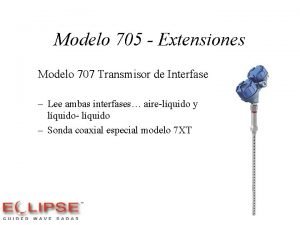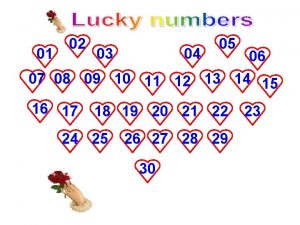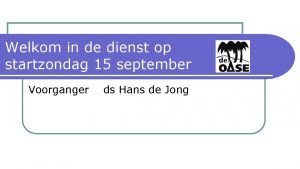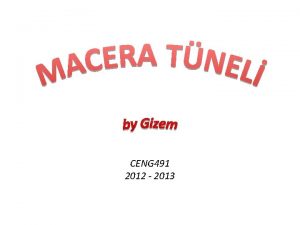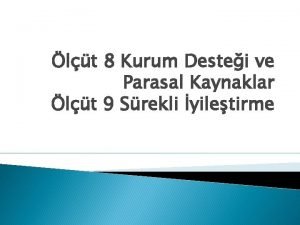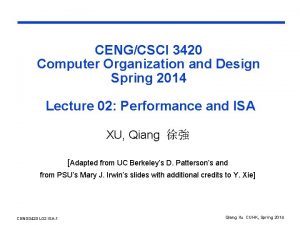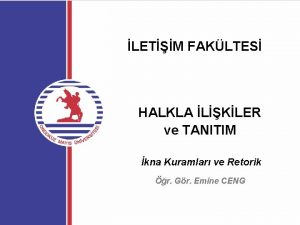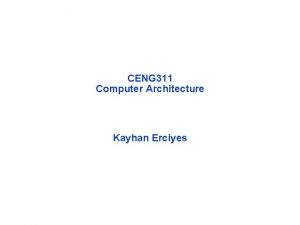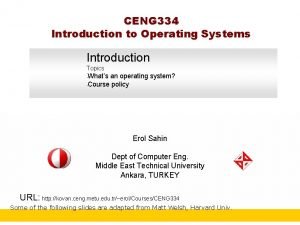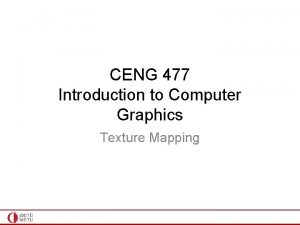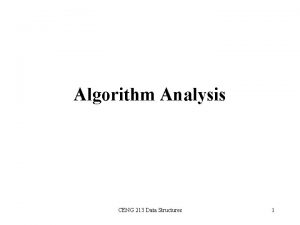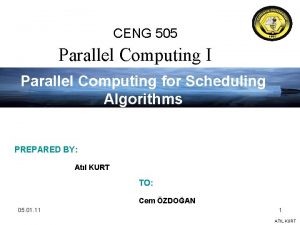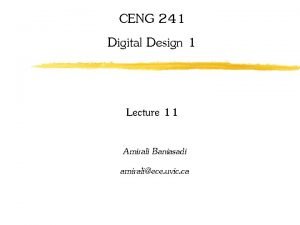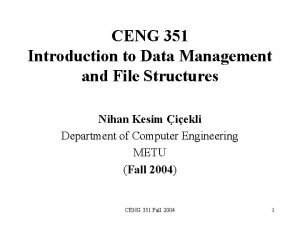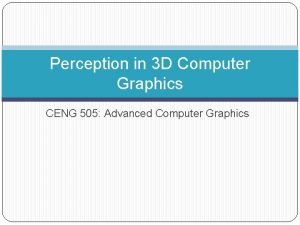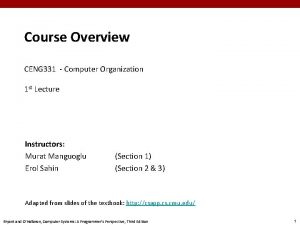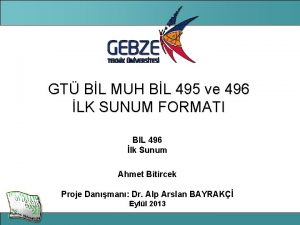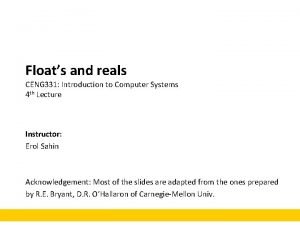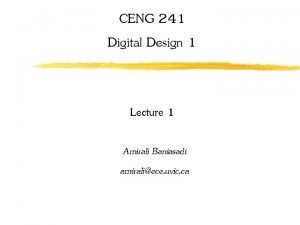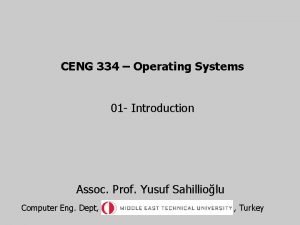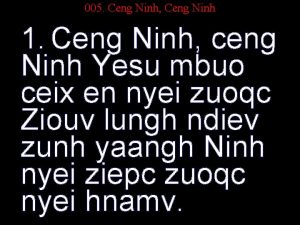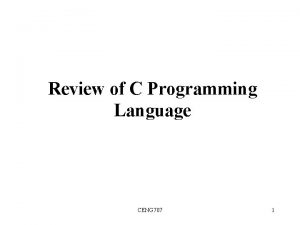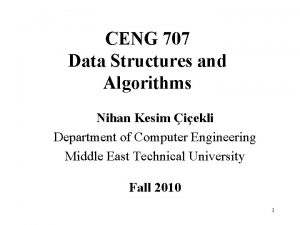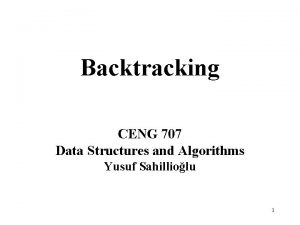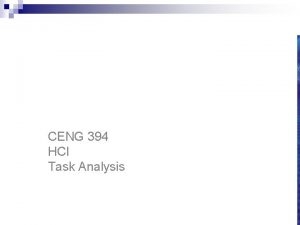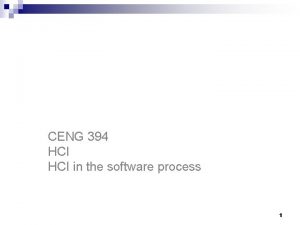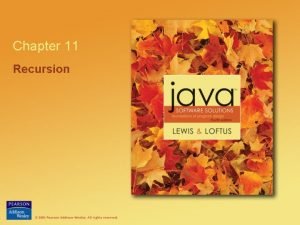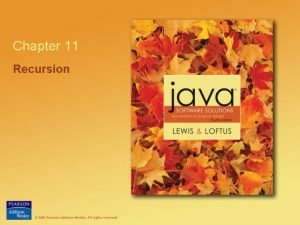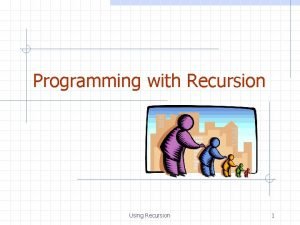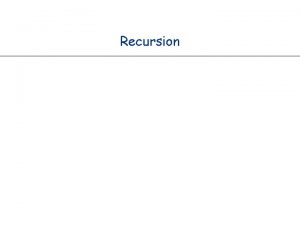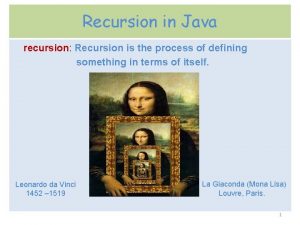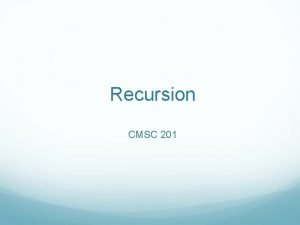Recursion CENG 707 1 Recursion Recursion is a





























![Binary Search in C int binary. Search(int an. Array[], int first, int last, int Binary Search in C int binary. Search(int an. Array[], int first, int last, int](https://slidetodoc.com/presentation_image_h2/638f52b4098fef7bec800cc39ad9c125/image-30.jpg)






- Slides: 36

Recursion CENG 707 1

Recursion • Recursion is a technique that solves a problem by solving a smaller problem of the same type. • A recursive function is a function invoking itself, either directly or indirectly. • Recursion can be used as an alternative to iteration. • Recursion is an important and powerful tool in problem solving And programming. • Recursion is a programming technique that naturally implements divide-and-conquer the problem solving methodology. CENG 707 2

The Nature of Recursion 1. 2. 3. One or more simple cases of the problem (called the stopping cases or base case) have a simple non-recursive solution. The other cases of the problem can be reduced (using recursion) to problems that are closer to stopping cases. Eventually the problem can be reduced to stopping cases only, which are relatively easy to solve. In general: if (stopping case) solve it else reduce the problem using recursion CENG 707 3

Four Criteria of A Recursive Solution 1. A recursive function calls itself. – This action is what makes the solution recursive. 2. Each recursive call solves an identical, but smaller, problem. – A recursive function solves a problem by solving another problem that is identical in nature but smaller in size. 3. A test for the base case enables the recursive calls to stop. – There must be a case of the problem (known as base case or stopping case) that is handled differently from the other cases (without recursively calling itself. ) – In the base case, the recursive calls stop and the problem is solved directly. 4. Eventually, one of the smaller problems must be the base case. – The manner in which the size of the problem diminishes ensures that the base case is eventually is reached. CENG 707 4

Four Questions for Constructing Recursive Solutions 1. How can you define the problem in terms of a smaller problem of the same type? 2. How does each recursive call diminish the size of the problem? 3. What instance of the problem can serve as the base case? 4. As the problem size diminishes, will you reach this base case? CENG 707 5

Factorial Function – Iterative Definition n! = n * (n-1) * (n-2) * … * 2 * 1 for any integer n>0 0! = 1 Iterative Definition in C: fval = 1; for (i = n; i >= 1; i--) fval = fval * i; CENG 707 6

Factorial Function - Recursive Definition • To define n! recursively, n! must be defined in terms of the factorial of a smaller number. • Observation (problem size is reduced): n! = n * (n-1)! • Base case: 0! = 1 • We can reach the base case, by subtracting 1 from n if n is a positive integer. Recursive Definition: n! = 1 n! = n*(n-1)! if n = 0 if n > 0 CENG 707 7

Factorial Function - Recursive Definition in C // Computes the factorial of a nonnegative integer. // Precondition: n must be greater than or equal to 0. // Postcondition: Returns the factorial of n; n is unchanged. int fact(int n) { if (n ==0) return (1); else return (n * fact(n-1)); } • This fact function satisfies the four criteria of a recursive solution. CENG 707 8

Tracing a Recursive Function • A stack is used to keep track of function calls. • Whenever a new function is called, all its parameters and local variables are pushed onto the stack along with the memory address of the calling statement (this gives the computer the return point after execution of the function) – For each function call, an activation record is created on the stack. • To trace a recursive function, the box method can be used. – The box method is a systematic way to trace the actions of a recursive function. – The box method illustrates how compilers implement recursion. – Each box in the box method roughly corresponds to an activation record. CENG 707 9

The Box Method (for a valued function) 1. Label each recursive call in the body of the recursive function. • • • For each recursive call, we use a different label to distinguish different recursive calls in the body. These labels help us to keep track of the correct place to which we must return after a function call completes. After each recursive call, we return to the labeled location, and substitute that recursive call with returned valued. if (n ==0) return (1); else return (n * fact(n-1) ) A CENG 707 10

The Box Method (continued) 2. Each time a function is called, a new box represents its local environment. Each box contains: – the values of the arguments, – the function local variables – A placeholder for the value returned from each recursive call from the current box. (label in step 1) – The value of the function itself. CENG 707 11

The Box Method (continued) 3. Draw an arrow from the statement that initiates the recursive process to the first box. – Then draw an arrow to a new box created after a recursive call, put a label on that arrow. printf(“%d”, fact (3)); CENG 707 12

The Box Method (continued) 4. After a new box is created, we start to execute the body of the function. 5. On exiting a function, cross off the current box and follow its arrow back to the box that called the function. – This box becomes the current box. – Substitute the value returned by the just-terminated function call into the appropriate item in the current box. – Continue the execution from the returned point. CENG 707 13

Box Trace of fact(3) CENG 707 14

Box Trace of fact(3) (continued) CENG 707 15

Box Trace of fact(3) (continued) CENG 707 16

A Recursive void Function – Writing a String Backward Problem: Write the given string of characters in reverse order. Recursive Solution: Base Case: Write the empty string backward. Recursive Case: How can we write an n-character string backward, if we can write an (n-1)-character string backward? • Strip away the last character, or strip away the first character write. Backward(in s: string) if (the string is empty) Do nothing // base case else { Write the last character of s write. Backward(s minus its last character) } CENG 707 17

Writing a String Backward in C // Writes a character string backward. // Precondition: The string s contains size characters, where size >= 0. // Postcondition: s is written backward, but remains unchanged. void write. Backward(char s[], int size) { if (size > 0) { // write the last character printf(“%c”, s[size-1]); // write the rest of the string backward write. Backward(s, size-1); // Point A } // end if // size == 0 is the base case - do nothing } // end write. Backward CENG 707 18

Box trace of write. Backward(“cat”, 3) CENG 707 19

Box trace of write. Backward(“cat”, 3) (continued) CENG 707 20

Box trace of write. Backward(“cat”, 3) (continued) CENG 707 21

write. Backward 2 in pseudocode write. Backward 2 (in s: string) if (the string is empty) Do nothing // base case else { write. Backward 2(s minus its first character) Write the first character of s } CENG 707 22

Multiplying Rabbits – The Fibonacci Sequence • Rabbits give birth so often. If rabbits did not die, their population would be quickly get out of hand. • Let us assume that: – Rabbits never die. – A rabbit reaches sexual maturity exactly two months after birth (at the beginning of its third month of life). – Rabbits are always born male-female pairs. – At the beginning of every month, each sexually mature male-female pair gives birth to exactly one male-female pair. • Question: – Suppose we start with a single newborn male-female pair in the first month. – What will be the number rabbit pairs in month n? CENG 707 23

Multiplying Rabbits – First Seven Months Month 1: 1 pair Month 2: 1 pair – since it is not yet sexually mature Month 3: 2 pairs – 1 original pair + a newborn pair from the original pair because it is now sexually mature. Month 4: 3 pairs – 2 pairs alive in month 3 + a newborn pair from original pair. Month 5: 5 pairs – 3 pairs alive in month 4 + 2 newborn pairs from 2 pairs alive in month 3. Month 6: 8 pairs – 5 pairs alive in month 5 + 3 newborn pairs from 3 pairs alive in month 4. Month 7: 13 pairs – 8 pairs alive in month 6 + 5 newborn pairs from 5 pairs alive in month 5. CENG 707 24

Recursive Solution to Rabbit Problem Observation: – All of the pairs alive in month n-1 cannot give birth at the beginning of month n. – Only, all of the pairs alive in month n-2 can give birth. – The number pairs in month n is the sum of the number of pairs alive in month n-1 plus the number rabbits alive in month n-2. Recurrence relation for the number of pairs in month n: rabbit(n) = rabbit(n-1) + rabbit(n-2) CENG 707 25

Recursive Solution to Rabbit Problem • Two base cases are necessary because there are two smaller problems. – rabbit(1) = 1 rabbit(2) = 1 Recursive Solution: rabbit(n) = 1 rabbit(n) = rabbit(n-1) + rabbit(n-2) if n is 1 or 2 if n > 2 • The series of numbers rabbit(1), rabbit(2), rabbit(3), … is known as Fibonacci Sequence. CENG 707 26

Recursive Solution to Rabbit Problem in C // Computes a term in the Fibonacci sequence. // Precondition: n is a positive integer. // Postcondition: Returns the nth Fibonacci number. int rabbit(int n) { if (n <= 2) return 1; else // n > 2, so n-1 > 0 and n-2 > 0 return (rabbit(n-1) + rabbit(n-2)); } // end rabbit • This rabbit function computes Fibonacci sequence (but inefficiently). CENG 707 27

Recursive Calls for rabbit(7) CENG 707 28

Binary Search Problem: Search a sorted array of integers for a given value. Recursive Binary Search Algorithm: binary. Search(in an. Array: Array. Type, in value: Item. Type) if (an. Array is of size 1) Determine if an. Array’s item is equal to value else { Find the midpoint of an. Array Determine which half of an. Array contains value if (value is in the first half of an. Array) binary. Search(first half of an. Array, value) else binary. Search(second half of an. Array, value) } CENG 707 29
![Binary Search in C int binary Searchint an Array int first int last int Binary Search in C int binary. Search(int an. Array[], int first, int last, int](https://slidetodoc.com/presentation_image_h2/638f52b4098fef7bec800cc39ad9c125/image-30.jpg)
Binary Search in C int binary. Search(int an. Array[], int first, int last, int value) // Searches the array items an. Array[first] through an. Array[last] for value by using a binary search. // Precondition: 0 <= first, last <= SIZE-1, where SIZE is the maximum size of the array, and // an. Array[first] <= an. Array[first+1] <=. . . <= an. Array[last]. // Postcondition: If value is in the array, the function returns the index of the array item that equals value; // otherwise the function returns -1. { int index; if (first > last) index = -1; // value not in original array else { // Invariant: If value is in an. Array, an. Array[first] <= value <= an. Array[last] int mid = (first + last)/2; if (value == an. Array[mid]) index = mid; // value found at an. Array[mid] else if (value < an. Array[mid]) index = binary. Search(an. Array, first, mid-1, value); // point X else index = binary. Search(an. Array, mid+1, last, value); // point Y } // end else return index; } // end binary. Search CENG 707 30

Box Trace of binary. Search (successful) Box traces of binary. Search with an. Array = <1, 5, 9, 12, 15, 21, 29, 31> a successful search for 9 CENG 707 31

Box Trace of binary. Search (unsuccessful) Box traces of binary. Search with an. Array = <1, 5, 9, 12, 15, 21, 29, 31> an unsuccessful search for 6 CENG 707 32

Box Method with A Reference Argument CENG 707 33

Growth-Rate Functions – Recursive Algorithms void hanoi(int n, char source, char dest, char spare) { Cost if (n > 0) { hanoi(n-1, source, spare, dest); cout << "Move top disk from pole " << source << " to pole " << dest << endl; hanoi(n-1, spare, dest, source); } } c 1 c 2 c 3 c 4 • The time-complexity function T(n) of a recursive algorithm is defined in terms of itself, and this is known as recurrence equation for T(n). • To find the growth-rate function for a recursive algorithm, we have to solve its recurrence relation. CENG 707 34

Growth-Rate Functions – Hanoi Towers • What is the cost of hanoi(n, ’A’, ’B’, ’C’)? when n=0 T(0) = c 1 when n>0 T(n) = c 1 + c 2 + T(n-1) + c 3 + c 4 + T(n-1) = 2*T(n-1) + (c 1+c 2+c 3+c 4) = 2*T(n-1) + c recurrence equation for the growth-rate function of hanoi-towers algorithm • Now, we have to solve this recurrence equation to find the growth-rate function of hanoi-towers algorithm CENG 707 35

Growth-Rate Functions – Hanoi Towers (cont. ) • We will use a simple method known as repeated substitutions to solve recurrence equations. T(n) = 2*T(n-1) + c = 2 * (2*T(n-2)+c) + c = 2 * (2*T(n-3)+c) + c = 23 * T(n-3) + (22+21+20)*c when substitution repeated i-1 th times = 2 i * T(n-i) + (2 i-1+. . . +21+20)*c when i=n = 2 n * T(0) + (2 n-1+. . . +21+20)*c = 2 n * c 1 + ( )*c (assuming n>2) = 2 n * c 1 + ( 2 n-1 )*c = 2 n*(c 1+c) – c So, the growth rate function is O(2 n) CENG 707 36
 Modelo eclipse
Modelo eclipse 707 meaning in islam
707 meaning in islam The boeing 747 is twice
The boeing 747 is twice Microcomputer
Microcomputer Opwekking 784
Opwekking 784 To understand recursion you must understand recursion
To understand recursion you must understand recursion Bahri tokmak
Bahri tokmak Mskü ceng
Mskü ceng Citp vs ceng
Citp vs ceng Ceng3420
Ceng3420 Emine ceng
Emine ceng Nem ceng
Nem ceng Iyte ceng
Iyte ceng Ceng 302
Ceng 302 Ceng334
Ceng334 Ceng 477
Ceng 477 Eur ing vs ceng
Eur ing vs ceng Ceng 213
Ceng 213 Ceng 505
Ceng 505 Ceng 考牌
Ceng 考牌 Ceng 112
Ceng 112 Ceng 241
Ceng 241 Emine ceng
Emine ceng Cow.ceng.metu.edu tr
Cow.ceng.metu.edu tr Ceng 477
Ceng 477 Ceng351
Ceng351 Odtü bilgisayar mühendisliği mezunları
Odtü bilgisayar mühendisliği mezunları 41/72 simplified
41/72 simplified Metu ceng curriculum
Metu ceng curriculum Gtü ceng
Gtü ceng Ceng 240 metu
Ceng 240 metu Texas. heres why.
Texas. heres why. Koü ceng
Koü ceng What is the difference between ethics and law
What is the difference between ethics and law Ceng 241
Ceng 241 Ceng334
Ceng334 Ceng302
Ceng302
